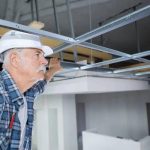An asbestos survey is a comprehensive inspection carried out on a property, specifically aimed at identifying the presence and condition of any asbestos-containing materials (ACMs). This survey is critical for maintaining safety standards in buildings constructed before 2000 when the use of this hazardous material was banned.
The first thing to anticipate during an asbestos survey is an initial walk-through by certified professionals. They will examine every corner of your building, including less obvious areas like attics, basements, and even inside heating systems. The purpose of this thorough investigation is to locate potential ACMs that could pose health risks if disturbed or damaged.
During the survey, samples may be collected from various materials throughout the building click here for more information further laboratory analysis. This process involves carefully removing small pieces from suspected ACMs and sealing them in air-tight containers to prevent any possible contamination. The number of samples taken depends on factors such as the size of the property and variety of materials used in its construction.
Following sample collection, these specimens are sent off to a specialized lab where they undergo rigorous testing under microscopic examination. It’s important to note that not all surveys require sampling; sometimes it’s enough just to identify potential risk areas based on visual assessment and knowledge about common uses of asbestos in construction.
Asbestos surveys also involve compiling detailed reports outlining findings and recommendations for managing any identified risks. These reports provide crucial information such as exact locations where ACMs were found, their current condition, type of asbestos present (if detected), risk level associated with each finding, along with advice on how best to manage these issues moving forward.
In most cases, if ACMs are found but remain undisturbed or encapsulated safely so fibers can’t escape into the air—no immediate action may be necessary other than regular monitoring for changes in conditions which might increase risks over time.
However, if high-risk situations are identified during an asbestos survey—such as deteriorating ACMs that could easily release hazardous fibers into the environment—immediate action will be required to ensure safety. This could involve encapsulation, repair, or removal by licensed professionals following strict safety protocols.
In conclusion, an asbestos survey is a comprehensive process involving thorough inspection of properties for ACMs, sample collection and analysis where necessary, and detailed reporting with management recommendations. It’s a vital step in ensuring the safety of buildings constructed before 2000 when asbestos use was prevalent. The ultimate goal is to protect occupants from potential health hazards associated with inhaling asbestos fibers—an invisible threat that can lead to serious lung diseases including asbestosis, lung cancer or mesothelioma.



